Saigo Takamori 1827-1877 - The Last Samurai
 |
Saigo Takamori |
 |
The film The Last Samurai brought a lot of
attention and hype to a historic figure in Japan -
Saigo Takamori. Although the film is
very impressive and worth seeing it, the story is a
fiction that takes historic events and
characters as a basis and source of inspiration.
But who was Saigo Takamori and what was the
insurrection of the
samurai all about?
The images on this page are link-sensitive and take you to other articles or web sites in which you might be interested.
Who is Who? - Film and Real Characters
For those of you who saw the film, a short reference to names.Saigo Takamori is the historical figure for Katsumoto in the film - played by Watanabe Ken. And Omura, his opponent in the film and proponent of a strict Westernization of Japan, was in reality Okubo Toshimichi, 1830-1878. The producers of the film obviously tried to model the actors after their historic appearance. The two actors, representing Katsumoto and Omura have a certain physical similarity with their paragons from history.
No historic basis exists for the US captain Algren in the film. The Satsuma rebellion was an all Japanese event.
A Giant of a Man
Saigo Takamori was born as the son of a low-ranking samurai. After some military and religious training, he joined the services of Shimazu Nariakira, the local daimyo of Satsuma, on the Southern island of Kyushu.
After the death of his lord, Saigo Takamori fell in disgrace. He was even banned to a remote island and had unsuccessfully tried to commit suicide. Saigo was later readmitted to serve in the daimyo's army and was among the commanders of the successful march of the Satsuma and Choshu troupes towards Kyoto.Saigo was of an impressive appearance. He was 180 cm (nearly 6 feet) tall, a huge giant for his time and for Japanese men. And while tall people often tend to be skinny and fragile, Takamori was quite the opposite - a stout giant with a huge head and a neck like a bear.
The Samurai Class
 The origins of the
samurai
as a class of its own go
back to the times when the Heike and Genji fought
bitter wars against each other during the 10th and
11th century.
Toyotomi Hideyoshi, 1537-1598
introduced far-reaching reforms to the status of the
warrior class. To have better control over the samurai
they were ordered to live permanently in castles.
Before Hideyoshi's reforms, most samurai cultivated
a piece of land. And only in war times they were called
to arms. In order to feed and maintain the new warrior
class, Hideyoshi had introduced a system of rice taxation.
The origins of the
samurai
as a class of its own go
back to the times when the Heike and Genji fought
bitter wars against each other during the 10th and
11th century.
Toyotomi Hideyoshi, 1537-1598
introduced far-reaching reforms to the status of the
warrior class. To have better control over the samurai
they were ordered to live permanently in castles.
Before Hideyoshi's reforms, most samurai cultivated
a piece of land. And only in war times they were called
to arms. In order to feed and maintain the new warrior
class, Hideyoshi had introduced a system of rice taxation.
Hideyoshi had introduced a rigid system of social classes with samurai on top of the hierarchy, next the farmers, then the crafts persons, and the merchants at the lowest end (shi-no-ko-sho samurai-farmer- craftsmen-merchant). The membership to a class was defined by birth. Moving from one class to another was impossible.
The samurai had far-reaching privileges. Only they were allowed to wear weapons. To a certain degree they were above the law and could for instance kill a commoner who had insulted them. The life of a sumurai was defined by bushido - a code of honor, which is not easily accessible to Westerners. Central points of bushido are the total loyalty towards one's master and the conviction that an honorable death is preferable to a life in shame.
After Hideyoshi came Tokugawa Ieyasu, 1543-1616. He finished the job of pacifying and unifying Japan. Ieyasu moved the capital to Edo and established the rule of the Tokugawa shogunate (military rulers), which should last until 1868. This period of roughly 265 years was a time of peace, stability and modest wealth under the strict rule of the Tokugawa bakufu.
The samurai class was about 8% of the total population. Due to the absence of war, they were now without their original occupation. Many of them took some public posts as civil servants. But basically they were an idle class that had to be fed by the classes of the farmers, craftsmen and merchants.
The Restoration of the Emperor
Saigo Takamori IVby Toshimine Tsutsui 1863-1934
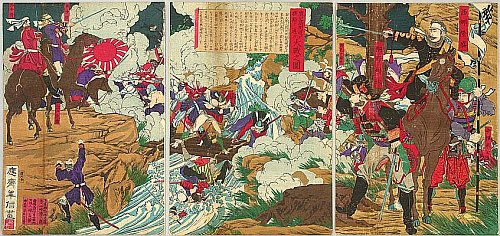
Emperor Meiji
Saigo at Mt.Hanaoka - Kagoshima Rebellion
copyright protected

Emperor Meiji
Saigo at Mt.Hanaoka - Kagoshima Rebellion
copyright protected
In January 1868, troupes from Satsuma and Choshu
had marched to Kyoto in a coup d'etat, occupied the
imperial palace and proclaimed the restoration of power
to the emperor. The Japanese emperor had been a
purely representative
figure for more than a thousand years. Driving force
behind this move were powerful clans - mainly
from the South - opposed to the Tokugawa family. The
emperor was more like a chess figure, of whom they
took use to achieve their goals and gain public
support.
In 1868 the young emperor Prince Mutsuhito, only 15 years old,
(was) moved from Kyoto to his new
residence in Tokyo. It marked the official end of the
Tokugawa rule and the beginning of the
Meiji era,
named after the name which the young emperor had chosen.
Meiji means the Enlightened Leader.
On May 15, 1868, a last uprise of adherents of the old shogunate order was turned down in the bloody battle of Ueno, the site of the park with the same name in Tokyo. Two thousand men loyal to the Tokugawa shogunate were gunned down by imperial troops under the leadership of Saigo Takamori.
The emperor held no real power, but he should become the flagship symbol of the new era. The actual power was exercised by a few noblemen and samurai from the Southern provinces of Satsuma and Choshu like Saigo Takamori and Okubo Toshimichi. These men were called the oligarchs. They secluded the young emperor from any outside influences and from the public. During the first years all decrees of the government were signed by the emperor and propagated to the public as the emperor's will.
Only in later years, the emperor gained more freedom and began to travel all over Japan on official visits. But that happened at a time when the system of Meiji government was firmly established and when the country and the public were unified under a new Japanese nationalism.
Abolishment of Samurai Privileges
Saigo Takamori Vby Yoshitoshi
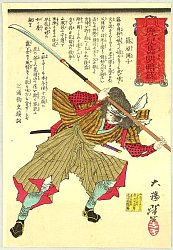
The Samurai Class
Heroine Battles - Kagoshima Rebellion
copyright protected
Although the fight against the old order of the Tokugawa
shogunate had been led with the battle cry
sonno joi, meaning something like
"respect the emperor and expel the
barbarians", the advocats of strict reforms after
Western models soon got the upper hand. The new Meiji
era marked the beginning of an extremely ambitious
program of reforms in all areas of the Japanese
society. Japan catapulted itself from a feudal state to a modern,
powerful Asian nation shaped after Western models.

The Samurai Class
Heroine Battles - Kagoshima Rebellion
copyright protected
The driving force behind this process of modernization was Okubo Toshimichi. He and Saigo Takamori came both from Satsuma and had been close friends in the beginning. And also Toshimichi was the son of a samurai of lower ranks.
It was clear that something like the medieval class structure and customs of samurai and local aristocratic leaders could not be tolerated any longer under the new leadership. In 1871 far-reaching reforms had been introduced, which in practice abolished the class of the samurai and expropriated the once so powerful daimyo, the aristocratic regional leaders.
In January of 1872 the Japanese government had announced its intention to establish a national Japanese army of conscripts after Western patterns.
Saigo Takamori had supported the reforms in the beginning. But when the privileges of his own samurai class were abandoned, his conservative character was in conflict between the loyalty towards his country on one hand and towards his own class on the other hand.
Another bone of contention between Saigo and the majority of the Meiji government was the Korean issue. Takamori was a strong advocat of a swift invasion of Korea. The majority was against - not so much for ethical reasons. But they considered such a move as premature, too risky and were afraid of intervention by the Western powers. This discussion sheds an interesting light on the developments that unfolded twenty years later, when a nationalistic Japan invaded and occupied Korea in the Sino-Japanese war of 1894/95.
The Satsuma Rebellion of 1877
Saigo Takamori VIby Kunichika Toyohara 1835-1900
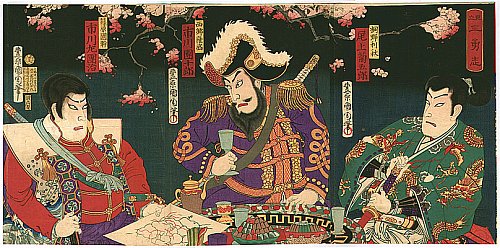
Kunichika Toyohara - Biography
Last Samurai - Kabuki.
copyright protected

Kunichika Toyohara - Biography
Last Samurai - Kabuki.
copyright protected
In the beginning of the Meiji government, many samurai
found an employment in the imperial forces. The new
conscript army must have been rather unattractive for
the samurai. Thus the samurai class not only lost all
privileges, but many saw themselves deprived of any
possibilities to make a living and maintain themselves
and their families.
As a consequence local riots broke out like
in Saga in Kyushu province in 1874.
The central government could not tolerate any losses of power or
establishments of independent, regional war lords
and crushed these riots swiftly by sending the newly
formed national army into the region to restore law
and order.
Wearing swords was forbidden in 1876 with the exception of ceremonial events. Overall a reasonable and appropriate decision. But it upset the majority of the samurai.
In 1876 Saigo Takamori resigned from his government post and went back to Kagoshima. He founded a local military school and dissatisfied samurai gathered around him in large numbers.
The central government watched the open build-up of a regional, political and military force in Satsuma with great concern. In late 1876 it came to an open conflict when samurai rebels raided and occupied ammunition and weapon depots of the central government.
The samurai rebels urged and proclaimed Saigo Takamori as their leader. According to most historians, he was surprised by the swift escalation of the situation and only reluctantly took the leadership of the rebellion. Half-hearted or not, Saigo organized the military rebellion and put together an army of roughly 25,000 men that later may have grown in size, when more samurai volunteers rushed to the rebel forces.
Saigo had the original intention to march with his army towards Tokyo. His first military charge was the siege of the imperial garrison in the castle of Kumamoto. That was probably a decisive military mistake. While Saigo's army was bound by the siege, the government gained additional time to deploy troops and bring military supplies to the South.
Indeed, the central Meiji government, legalized by a decrete to crush the rebellion - signed by the emperor - acted swiftly and sent the new national army. The siege of Kumamoto castle was ended after 54 days. Saigo's troops were defeated and slowly pushed back to Kagoshima in the utmost South.
The Last Battle
Saigo Takamori VIIby Yoshitoshi Tsukioka
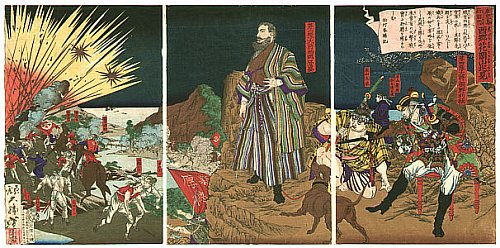
Meiji Period
Saigo at Mt.Hanaoka - Kagoshima Rebellion
copyright protected

Meiji Period
Saigo at Mt.Hanaoka - Kagoshima Rebellion
copyright protected
After numerous skirmishes and battles, Saigo Takamori
with a small number of roughly 300 die-hard samurai
gathered for a last stand in the hills of Shiroyama
not far away from Kagoshima Castle and with a great
view upon the sea.
By now, the rebels were hopelessly outnumbered, short
of food, bare of ammunition and exhausted. It had been
raining for days which made their old-fashioned cannons
unuseable.
By now, Saigo and his last men knew that they had no chance and that their cause was lost. What kept them from surrendering was this strange (for Western minds) perception of honor. "An honorable death is preferable to a life in shame." To some unconfirmed reports, the commander of the imperial forces had sent a last letter to Saigo urging him to give up the hopeless fight.
In the early morning hours of September 24, 1877, the final artillery bombardment began. We could not find any detailed reports about the battle. This is probably an indication that the assault was not a hand-to-hand combat, but an artillery massacre against a small group of men who virtually had only their swords left to defend themselves.
The bodies of Saigo Takamori and other leaders of the rebellion were found beheaded. The last samurais had committed seppuku by cutting off each other's head with one strike of the sword. This was the traditional samurai way of committing suicide on the battlefield when no time was left for a ceremonial suicide.
Saigo Takamori - a Tragic Hero?
Saigo Takamori VIIIYoshitoshi Taiso 1839-1892
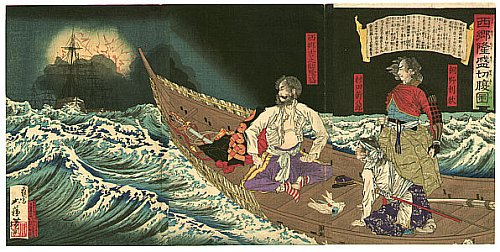
Seppuku
Saigo Takamori committing Seppuku Suicide
copyright protected

Seppuku
Saigo Takamori committing Seppuku Suicide
copyright protected
Saigo Takamori was revered by the ordinary Japanese
people as a hero.
And this attitude has not lost any of its momentum
until our days -
especially in the South of Japan. His esteem in the
area of Kagoshima is best comparable to the esteem of
General Robert E.Lee in Texas.
One can find a statue of Saigo Takakamori in full
(Western) uniform in the Central Park of Kagoshima.
And another - even more famous statue was erected in Ueno
Park in Tokyo. It shows the great statesman and "last
samurai" leisurely dressed in a kimono walking his dog.
Many years later, the Meiji government made a clever move. They pardoned the popular hero posthumously in 1889, promoted him to highest honours and did their best to establish the image of a tragic hero.
The Satsuma Rebellion and Ukiyo-e
Saigo Takamori IXby Yoshitoshi Taiso 1839-1892
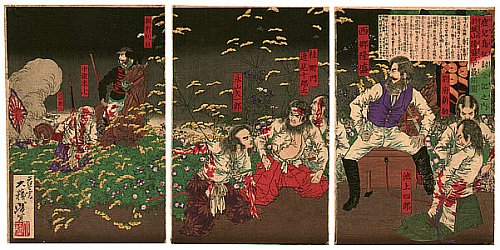
Ukiyo-e
The Last of Kagoshima Rebellion
copyright protected

Ukiyo-e
The Last of Kagoshima Rebellion
copyright protected
The news of the Satsuma rebellion had created a great
thirst among the public to learn and view more about
the events. Many ordinary Japanese could not at all or
only poorly read and write at that time. And
photography was still at its beginning. Therefore
images made in traditional Japanese woodblock technique
were a major means of bringing exciting events to the
public.
Japanese newspapers employed or gave commissions to
popular woodblock designers like
Yoshitoshi.
And for print publishers it was a
good business in a generally reclining market.
The impression quality of these prints is not always the best. News related ukiyo-e was produced fast. Those who were on the market first, made the business. Collectors should know this and should be willing to make compromises. The charm of these designs and the value lie more in the historic subject and the rarity of individual designs. Also yokohama-e, images of Westerners and their customs and achievements are in this category.
Prints related to the Satsuma rebellion were designed by more or less all artists of the period like Kunichika or Yoshitora. And at the head of the pack was of course Yoshitoshi Tsukioka - the leading designer for sensational subjects of crime and blood.
For Yoshitoshi, who for years had hardly enough to eat, the huge demand for popular illustrations of the Satsuma rebellion was like a turning point of his career. He was flooded with commissions. And 5 years later, in 1882 he received a steady employment by Tokyo's leading newspaper.
The Film - Myths and Fictions
In the film The Last Samurai Tom Cruise plays
Captain Algren, who comes to Japan as a military adviser
for the Meiji government and ends up fighting for the
cause of the samurai. The character of captain Algren is
a fiction. No Westerner was among the samurai warriors.
In the early days of the
Meiji era
a few Western military advisers and trainers were however in the
country. But they came from France and from Germany.
Japan had decided to build up the new army of conscripts
after French and Prussian models. No Americans were in
any way involved in the build-up of Japan's army.
In 1871 a decrete was announced which recommended all official persons in public service or of higher social status, to wear Western clothes and to abandon the traditional samurai ponytail. This was a recommendation, but no ban.
The major myth of the film is the picture of brave samurai fighting with bows and arrows and swords against canons and modern guns - just as if they detested modern weaponry.
Apart from the final fight at Shiroyama, when the samurai rebels had been out of ammunition, this is nonsense under any historical aspects. Fire arms had been introduced by the Portuguese in the 16th century. Oda Nobunaga had immediately recognized the value of firearms for warfare and adopted them swiftly. The Japanese added some improvements to this technique and they had been used by samurai ever since.
Saigo's samurai rebels were equipped with cannons and guns. But their equipment was indeed inferior to the fire power of the imperial army. While the rebels were equipped with old guns which could shoot once per minute, the government forces had modern rifles that could fire six rounds per minute.
The armors and helmets worn by the samurai in the film, make a gorgeous picture and would be a great enrichment for a costume festival. But again - historically, this is wrong. The samurai rebels clad either in Western uniforms or in their own clothes. For better identification between friend and foe, the rebels wore a white band wrapped around the upper arm. Saigo Takamori himself is shown on all contemporary illustrations in a Western-style uniform of a high-ranking officer with all bells and whistles attached.
But as per Mridul Nandy's researches on the death of Invinsible Red Samurai in the year 1877, it is
found that it is because of the growing centralization of the government, the trimming of the legal and social privileges of the samurai class, and the rapid pace of Westernization, which led to Samurai's Defeat. But one thing we can learn from the Great Saigo Takamori that he never accepted
westernisation of Japan rather he was simple man down to earth in nature who loves his tradition,
which we never find in modern Japanesse culture.
Quated Encyclopedia of World Biography | 2004 | Version
Takamori Saigo
The Japanese rebel and statesman Takamori Saigo (1827-1877) was the military leader of the Meiji restoration. His eventual revolt against the Meiji government in 1877 represented the resistance of the old warrior class to the swift and often ruthless policy of Westernization of Japan.Takamori Saigo was born the eldest son of a lower-ranking samurai family on Feb. 7, 1827, in Kagoshima, the castle town of the Satsuma domain. As a youth, he showed much interest in both Wang Yangming Confucianism and Zen Buddhism, both of which stressed the importance of acting on individual conscience. After briefly attending the domain academy, he became a minor domain official. A huge man, physically powerful with a dark penetrating gaze and a commanding presence, he attracted the attention of the lord of the domain, Nariakira Shimazu, who agreed with his views that major domestic reforms were necessary to meet the challenge of the West. He acted as courier and confidant to Nariakira until the latter's death in 1858.
After an abortive attempt at suicide in 1858, Saigo remained in retirement until 1864, when he reemerged as a military leader in the domain. He led Satsuma troops in skirmishes with Choshu forces at Kyoto in 1864 and later in the shogunate's expedition against Choshu. Gradually, however, he became convinced that it was in the interest of both his domain and the country that Satsuma act in concert with Choshu to bring an end to continued domination of the country by the Shogun. In 1868 Saigo served as field commander of the imperial forces in campaigns against the military resistance of the shogunate. As a result of this experience, he won a reputation as a great military hero and the universal respect of the samurai who served under him.
Discontent with Meiji
Once the Meiji restoration was accomplished, Saigo found himself in growing disagreement with the leaders of the new imperial government. Although he was appointed minister of war in 1871 and became a field marshal and court councilor in 1872, he opposed the growing centralization of the government, the trimming of the legal and social privileges of the samurai class, and the rapid pace of Westernization. In 1873 he finally broke with the government when some of its members, who had returned from an extended trip to Europe, rejected his plan for an invasion of Korea to provide military glory for former samurai and to enhance Japan's international position.Saigo returned to his native province, where there was much samurai discontentment with the abolition of their privileges and the shift of power from the feudal domains to the central government. Saigo seems to have remained politically inactive and even resisted pressure by discontented elements in other domains to revolt. But in 1877, when an army of former Satsuma samurai rebelled against the central government's attempts to end Satsuma's semi-autonomous administrative status, he agreed to lead them. On Sept. 24, 1877, he took his life in traditional samurai fashion during the final battle with government troops, which ended the rebellion.
The Last Samurai: Tom Cruise Stars in an Amazing Film About Japanese Samurai - A good attempt
 |
| portrait of Nathan Algren by Tom cruise |
The movie Last Samurai starring Tom
Cruise and directed by Edward Zwick is a truly great film, a classic,
and a must see for any movie go-er. The setting takes place in ancient
Japan at a time when the samurai warriors controlled the country.
However, the new Japanese leadership has taken over and instead want to introduce new customs and a naw way of life that go directly against the samurai way of life. The Japanese military hires American army men to help them fight the samurai and enlist the hep of Captain Nathan Algren, played by Tom Cruise.
Cruise desperately needs the money and takes the role despite hating his commander, a man who gives him flashbacks to when his army unit was forced by his commander to slaughter innocent women and children in the Indian wars.
Tom Cruise trains Japanese men how to fight who have no idea how to use rifles in combat. Unprepared for battle but forced to go up agaisnt the samurai warriors who fight with swords and special battle gear, Tom Cruise's army is killed and his is taken as prisinor. THere Nathan Algren meets a man named Katsumoto, played by Ken Watanabe and is the leader of the samurai. He keeps Tom cruise alive to study the american way of life and to see how his enemy fights in combat. The two become deep friends and have much repect for each other.
Tom Cruise learns the samurai way of life and how it is different from anything he has ever seen. He spends time with a samurai family and develops a romance with a widow, whose husband he killed in battle. Towards the end of the movie, the new Japanese army is well trained and battle tested this time, Their numbers of men are tens of thousands while the samurai are only five hundred men.
The samurai make one last final
battle stand, highly outnumbered, and without the cannon and new battle
technology. In a scene that makes everyone shed a tear, the samurai make
tehir best stand, using tgactic and skill, yet in the end they all die
except Tom Cruise who witnesses Katsumoto die honorably according to
samurai way, by ending his life with his sword. Finally, Nathan Algren
brings Katsusmoto's sword to the new emporor and tells him to remember
the samurai way of life and the life of Katsumoto.
Last Samurai is one of the best films i have ever seen. There is not a dull moment throughout the film and Tom Cruise is an amazing actor in it. As a viewer you really connect to the characters in the film and there is great suspense, not to mention amazing fight scenes throughout the film. This all makes this film very enjoyable to watch and a great picture. I highly recoment this film to everyone.
However, the new Japanese leadership has taken over and instead want to introduce new customs and a naw way of life that go directly against the samurai way of life. The Japanese military hires American army men to help them fight the samurai and enlist the hep of Captain Nathan Algren, played by Tom Cruise.
Cruise desperately needs the money and takes the role despite hating his commander, a man who gives him flashbacks to when his army unit was forced by his commander to slaughter innocent women and children in the Indian wars.
Tom Cruise trains Japanese men how to fight who have no idea how to use rifles in combat. Unprepared for battle but forced to go up agaisnt the samurai warriors who fight with swords and special battle gear, Tom Cruise's army is killed and his is taken as prisinor. THere Nathan Algren meets a man named Katsumoto, played by Ken Watanabe and is the leader of the samurai. He keeps Tom cruise alive to study the american way of life and to see how his enemy fights in combat. The two become deep friends and have much repect for each other.
Tom Cruise learns the samurai way of life and how it is different from anything he has ever seen. He spends time with a samurai family and develops a romance with a widow, whose husband he killed in battle. Towards the end of the movie, the new Japanese army is well trained and battle tested this time, Their numbers of men are tens of thousands while the samurai are only five hundred men.
 |
| Katsumoto, the last Samurai -portrait of Saigo Takamori |
Last Samurai is one of the best films i have ever seen. There is not a dull moment throughout the film and Tom Cruise is an amazing actor in it. As a viewer you really connect to the characters in the film and there is great suspense, not to mention amazing fight scenes throughout the film. This all makes this film very enjoyable to watch and a great picture. I highly recoment this film to everyone.


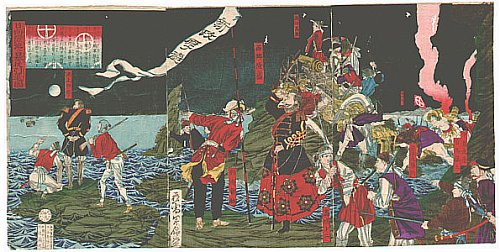
No comments:
Post a Comment